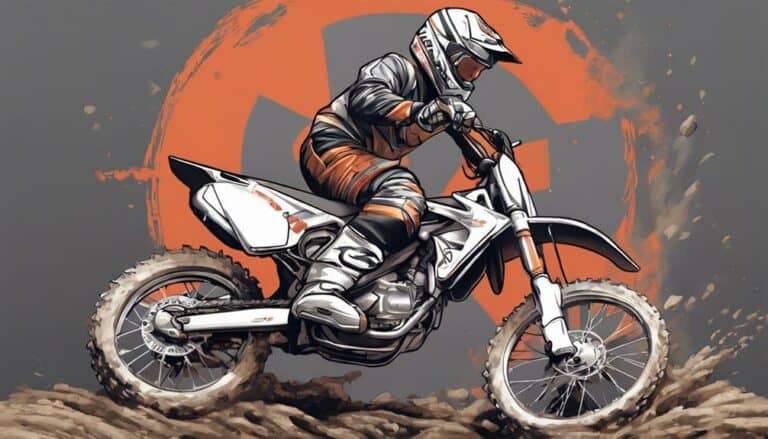When your dirt bike runs lean, it's like trying to run a marathon on an empty stomach – it's just not going to work out well. From causing engine overheating to decreased performance, a lean-running bike can be a headache.
But why does this happen? Well, buckle up as we uncover the mystery behind what makes your dirt bike lean and how you can tackle this issue head-on for a smoother ride.
Key Takeaways
- Dirty air filter restricts air intake, leading to a lean mixture
- Air leaks introduce excess air, causing lean conditions and potential engine damage
- Clogged jets in the carburetor restrict fuel flow, contributing to lean running
- Incorrect carburetor settings upset air-fuel ratio, leading to lean conditions
Common Causes of Lean Running
If your dirt bike is experiencing lean running, various common factors could be contributing to this issue. One important element to inspect is the spark plug. A lean side condition can lead to the spark plug appearing white or blistered, indicating a potential problem with the air and fuel mixture. Additionally, the pilot circuit in the carburetor plays a significant role in delivering fuel at low speeds. If this circuit is clogged or improperly adjusted, it can result in poor throttle response and lean running.
Additionally, the air and fuel mixture must be balanced for best performance. Any deviation towards a lean mixture can be detrimental to the engine's operation. Issues such as a clogged or dirty fuel filter can restrict the flow of fuel, leading to a lean condition. Also, incorrect carburetor settings, especially those that lean towards less fuel delivery, can cause the engine to run lean. By addressing these common causes systematically, you can make sure that your dirt bike operates at its best performance level without experiencing lean running issues.
Effects of Air Leaks on Lean Condition
Air leaks in the dirt bike's system can lead to a lean condition by introducing unmeasured air into the combustion chamber.
- Lean conditions caused by air leaks can result in engine overheating, which can be emotionally distressing for any rider.
- Decreased performance due to a lean mixture can be frustrating, especially when you need your dirt bike to perform at its best.
- The potential engine damage resulting from a lean condition caused by air leaks can be financially burdensome and emotionally taxing.
Detecting air leaks promptly is important to prevent these effects. Regular inspections of intake boots, gaskets, and fittings can help maintain the proper air-fuel balance and overall engine health.
Impact of Dirty Air Filter on Lean Mixture
A dirty air filter in a dirt bike can directly contribute to a lean mixture by restricting air flow to the engine. When the air filter is clogged with dirt and debris, it hinders the amount of air that can enter the engine. This reduction in air intake means the engine receives less oxygen, leading to a higher air to fuel ratio. Consequently, the fuel mixture becomes vital, with insufficient fuel compared to the amount of air present.
Running a dirt bike with a lean mixture can result in the engine running hotter than usual, potentially causing damage to internal components over time. To prevent a lean running condition, it's essential to regularly maintain the air filter by cleaning or replacing it when necessary. By ensuring proper air flow, you can avoid spark plug fouling, poor throttle response, and other issues associated with running a dirt bike with a lean fuel mixture.
Role of Fuel System in Lean Running
The fuel system plays an important role in determining whether a dirt bike is running lean. Issues within the fuel system can lead to an imbalance in the air-fuel mixture, causing the engine to run hotter and potentially damaging components. Consider the following:
- Clogged Jets: When jets in the carburetor become obstructed, fuel flow is restricted, leading to a lean condition as the engine receives insufficient fuel.
- Carburetor Adjustment: Incorrectly adjusted carburetors can introduce more air into the mixture than necessary, resulting in a lean running engine.
- Vacuum Leaks: Leaks in the intake system can allow extra air to enter, upsetting the air-fuel ratio and causing the bike to run lean.
Ensuring the fuel system is well-maintained and free from issues such as clogged jets, improper adjustments, and vacuum leaks is essential in preventing lean running. By addressing these factors, you can optimize your dirt bike's performance and reliability.
Addressing Lean Running Issues
To rectify lean running issues in a dirt bike, a thorough inspection and potential adjustment of the fuel system components are imperative. Begin by checking for clogged jets in the carburetor, which can restrict fuel flow and lead to a lean mixture. If clogs are present, clean or replace the affected jets to restore proper fuel delivery.
Additionally, consider adjusting the carburetor screw to regulate the gas flow and achieve the correct air-fuel ratio. A faulty carburetor could also be the culprit behind lean running; in such cases, cleaning or replacing the carburetor may be necessary. Remember to consult the owner's manual for specific guidance on carburetor adjustments to avoid causing further issues.
Ignoring lean running problems can result in severe engine damage and decreased performance, so prompt action is essential to maintain the health and efficiency of your dirt bike.
Conclusion
You now understand the common causes of a lean running dirt bike, such as air leaks, dirty air filters, and fuel system issues.
Did you know that 70% of dirt bike engine failures are due to running lean?
By addressing these issues promptly and ensuring proper maintenance, you can prevent costly damage and keep your dirt bike running smoothly for years to come.
Stay vigilant and keep your engine in peak condition to enjoy peak performance on every ride.

